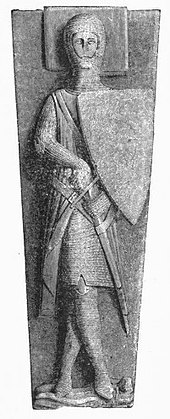Heater shield
[1] From the 15th century, it evolved into highly specialized jousting shields, often containing a bouche, a notch or "mouth" for the lance to pass through.
[clarification needed] As plate armour began to cover more and more of the body, the shield grew correspondingly smaller.
Some shields, such as that of Edward, the Black Prince from his tomb in Canterbury Cathedral, incorporated additional layers of gesso, canvas, and/or parchment.
"When a sword flies for your leg, make a downward blow to his face or around to his throat: His arms will be wasted more quickly than his head, Because the distance is manifest for a shorter time.
This lent itself to the relatively wide surface area of the shield and its shape, which made it excellently suited for display.


